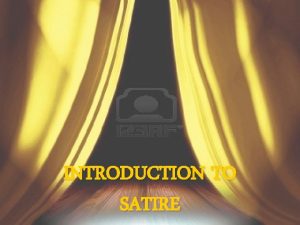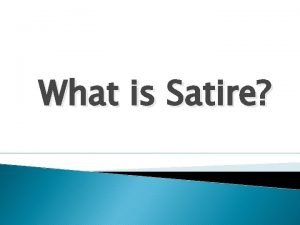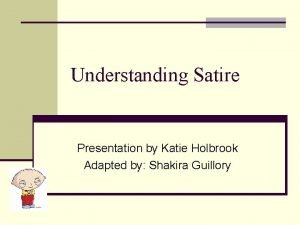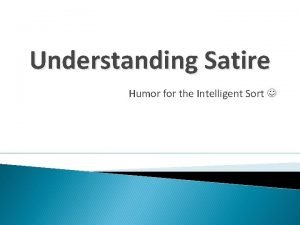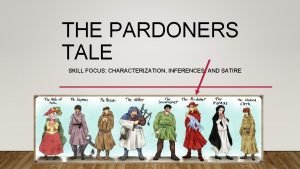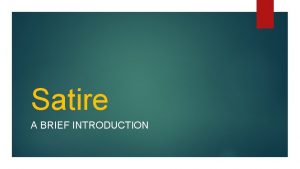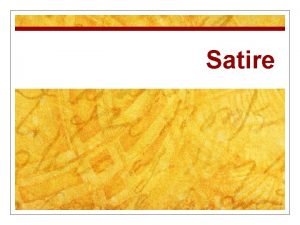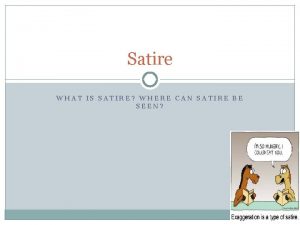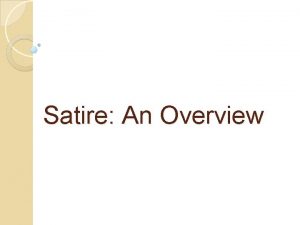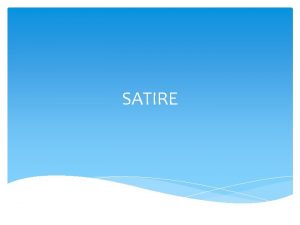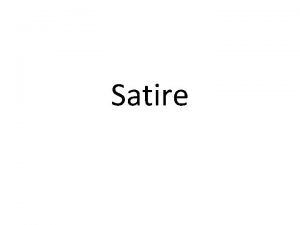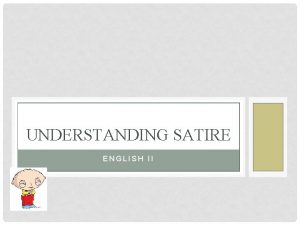Satire An Introduction What is satire Satire is













- Slides: 13

Satire: An Introduction

What is satire? § Satire is a literary form in which human follies or vices are held up to ridicule or scorn. § Satire often pokes fun at or ridicules some aspect of society or a topic of interest in order to prove a point. § It uses humor with an edge.

Where would I find satire? § In cartoons like Sponge Bob or The Simpsons § In cartoons on the editorial pages of publications § Late night tv shows like Saturday Night Live or The Jon Stewart Show § In music in songs by artists such as Weird Al and Cletus T. Judd

Characteristics of Satire § Satire is easily dated because it is often inspired by current events. It may be hard to understand if one is not familiar with the event that is being referenced. § It uses edgy humor in an attempt to reform or change human behavior or values. § It compares reality to what is ideal, but why is this problematic? § Any individual or issue could be fair game for the writer of satire.

Major Devices of Satire § Parody—a take-off or imitation of a work of art or literature § Understatement—saying less than what is really mean “Oh, those chemo treatments were a piece of cake” § Exaggeration—overstating or expanding the facts relating to an issue

More Devices of Satire § Some satire contains hyperboles—extreme exaggerations. § Negative comments or insults may be made regarding issues related to society (politics, health care, racial issues, etc)

Major Devices of Satire Irony is the tension between what the audience expects to happen and what actually happens. § A. Dramatic irony—the audience knows something a character does not § B. Verbal irony—a character means the opposite of what he or she says § C. Situational irony—the outcome of the situation is opposite of what is expected

Major Devices of Satire § Satire often contains stereotypes, which is a generalization assigned to an entire group. § What stereotypes of Kentuckians are represented in this photo? § What stereotypes are often applied to teenagers today?

Major Devices of Satire § Reversal, which is presenting the opposite of normal order.

Major Devices of Satire § Incongruity: Presenting things that are absurd in relation to the surroundings.

Understanding Satire § To understand the message of satire, it’s important to ask yourself these questions: § What is the issue being targeted in the work? § How does the creator seem to feel about the issue? § What does he seem to think should change about the issue?

Understanding Satire: What is the message in this?

Cartoon Analysis
 Invective satire
Invective satire Introduction paragraph format
Introduction paragraph format Technique of satire
Technique of satire Satire examples
Satire examples Satire techniques
Satire techniques The three golden questions of satire are:
The three golden questions of satire are: Mr collins satire
Mr collins satire Which word best characterizes the pardoner in this passage?
Which word best characterizes the pardoner in this passage? The three golden questions of satire are:
The three golden questions of satire are: Great gatsby meaning
Great gatsby meaning Satire advertisement
Satire advertisement Satire examples in literature
Satire examples in literature Shrek plot summary worksheet answers
Shrek plot summary worksheet answers Family guy satire analysis
Family guy satire analysis
